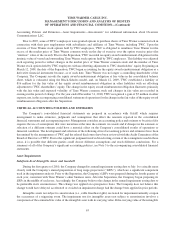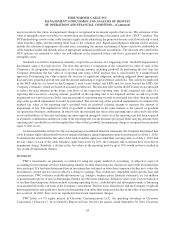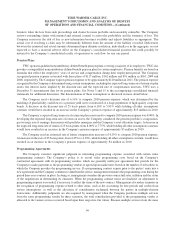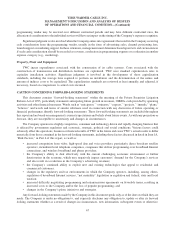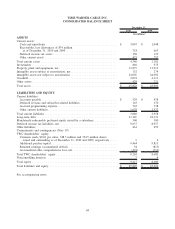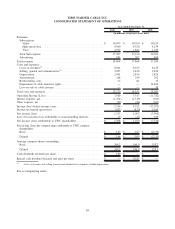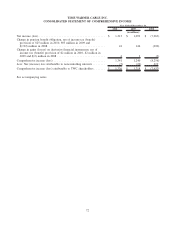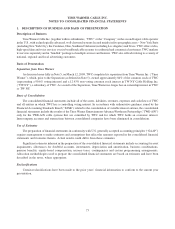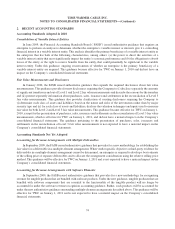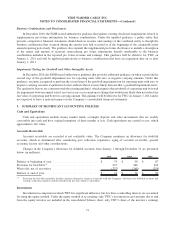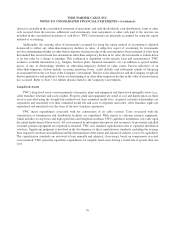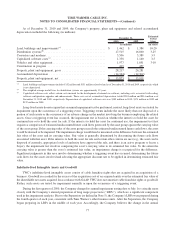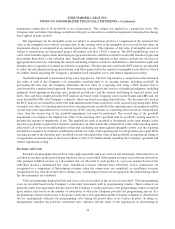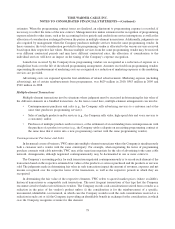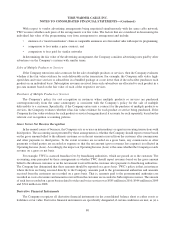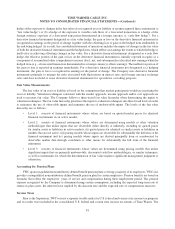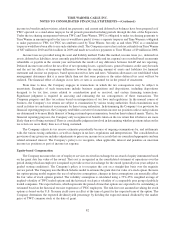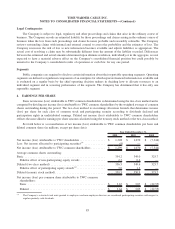Time Warner Cable 2010 Annual Report Download - page 85
Download and view the complete annual report
Please find page 85 of the 2010 Time Warner Cable annual report below. You can navigate through the pages in the report by either clicking on the pages listed below, or by using the keyword search tool below to find specific information within the annual report.TIME WARNER CABLE INC.
NOTES TO CONSOLIDATED FINANCIAL STATEMENTS
1. DESCRIPTION OF BUSINESS AND BASIS OF PRESENTATION
Description of Business
Time Warner Cable Inc. (together with its subsidiaries, “TWC” or the “Company”) is the second-largest cable operator
in the U.S., with technologically advanced, well-clustered systems located mainly in five geographic areas – New York State
(including New York City), the Carolinas, Ohio, Southern California (including Los Angeles) and Texas. TWC offers video,
high-speed data and voice services over its broadband cable systems to residential and commercial customers. TWC markets
its services separately and in “bundled” packages of multiple services and features. TWC also sells advertising to a variety of
national, regional and local advertising customers.
Basis of Presentation
Separation from Time Warner
As discussed more fully in Note 5, on March 12, 2009, TWC completed its separation from Time Warner Inc. (“Time
Warner”), which, prior to the Separation (as defined in Note 5), owned approximately 84% of the common stock of TWC
(representing a 90.6% voting interest) and a 12.43% non-voting common stock interest in TW NY Cable Holding Inc.
(“TW NY”), a subsidiary of TWC. As a result of the Separation, Time Warner no longer has an ownership interest in TWC
or TW NY.
Basis of Consolidation
The consolidated financial statements include all of the assets, liabilities, revenues, expenses and cash flows of TWC
and all entities in which TWC has a controlling voting interest. In accordance with authoritative guidance issued by the
Financial Accounting Standards Board (“FASB”) related to the consolidation of variable interest entities, the consolidated
financial statements include the results of the Time Warner Entertainment-Advance/Newhouse Partnership (“TWE-A/N”)
only for the TWE-A/N cable systems that are controlled by TWC and for which TWC holds an economic interest.
Intercompany accounts and transactions between consolidated companies have been eliminated in consolidation.
Use of Estimates
The preparation of financial statements in conformity with U.S. generally accepted accounting principles (“GAAP”)
requires management to make estimates and assumptions that affect the amounts reported in the consolidated financial
statements and footnotes thereto. Actual results could differ from those estimates.
Significant estimates inherent in the preparation of the consolidated financial statements include accounting for asset
impairments, allowances for doubtful accounts, investments, depreciation and amortization, business combinations,
pension benefits, equity-based compensation, income taxes, contingencies and certain programming arrangements.
Allocation methodologies used to prepare the consolidated financial statements are based on estimates and have been
described in the notes, where appropriate.
Reclassifications
Certain reclassifications have been made to the prior years’ financial information to conform to the current year
presentation.
73


